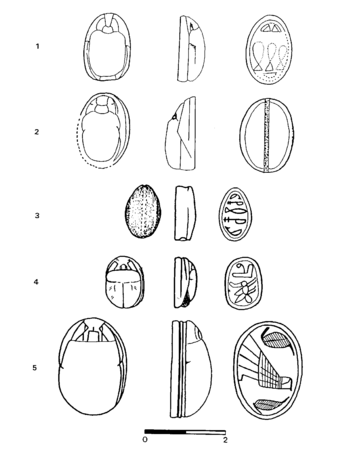III. Conclusions
Ten trenches, Trenches 4-23, to the north-west of Trenches 1 and 2 from the 1999 campaign at Tell el-cAjjul were opened during the season of 2000. The entire area of excavation was back-filled at the end of the season. Four of the trenches revealed traces of earlier excavations, maybe from Petrie’s campaigns in the 30s, of which any documentation is lacking.
Eight horizons, of which H8-H2 contain architectural remains, were exposed. Five main phases of occupation – or possibly six if we consider H6 as a separate phase – were recognized, if H1 in the north of the area, which contains only one structure (tomb?), is excluded. There is also one sub-phase in each of H5 to H2 which can be seen from clear evidence of repair after a limited destruction. Each of the occupational phases H8-H2 came to an end through conflagrations. However, surviving walls were re-used and incorporated into new constructions. H8 is the only phase in which stone walls were built.

The scarabs.
The pottery from H7 to H2 provides the possibility of cross-dating because of many imports, i.e. 941 in number. The majority comes from Cyprus (a total of 830 sherds/vessels in H8 to H1/Coll), and Egypt (a total of 31 sherds/vessels) and the Jordan Valley (a total of 55 sherds/vessels). Cypriote imports are Base-ring I and II, Bichrome Wheel-made, Red and Black Slip, Monochrome, Red Lustrous Wheel-made, Red-on-Black/Red-on-Red, White Painted V/VI, White Shaved, and White Slip I and II. There are also 22 sherds of Black Lustrous Wheel-made Ware. Egyptian and Egyptian-style pottery is represented by shallow bowls and piriform and carinated jars, the latter two of which were very likely imports from Upper Egypt. Imports from the Jordan Valley/southern Lebanon are Chocolate-on-White Bichrome, Chocolate-on-White I and II, and Eggshell Ware. There are also two sherds of Grey Ware, which are imported from the Middle Euphrates (?) and a link to Anatolia and northern Syria. There are four body sherds of Mycenaean-type in addition to the partly preserved Mycenaean-type vessel from 1999.
Small finds include five scarabs – three from this season and two from the previous one – from the second part of the 15th Dynasty, four of which are from the area of occupation and one from a tomb. Others are objects of bronze, among them being needles, toggle pins, a limb cover (armour) and jewellery which includes a ring and a bead. A small bowl and a pendant of silver and one of sheet gold with the image of Hathor should be mentioned. Objects of stone include a calcite dagger pommel and bowls of basalt. There are also some figurines of earthenware, one of which is of Egyptian-style, and objects of faience. Finally some incised bone plaques should be mentioned. One of these depicts the hind part of a feline.
Horizons 8 to 2, which are the layers which contain architecture, are preliminary dated within the later part of the Middle Bronze Age and the Late Bronze Age IB/IIA. The detailed preliminary relative chronology of the sequence of occupation can be studied in Table 1.
There are four burials and three additional features which are very likely remains of burials. Only two of the burials are undisturbed and provide the possibility of dating by means of the associated burial gifts. The oldest burial is from the Middle Bronze Age IIC or perhaps its end and the second is from the beginning of the Late Bronze Age.
The provenance study of the 48 samples of pumice from Tell el-cAjjul (from colluvial down to H5; see below) with the support of neutron activation analyses (NAA, Vienna; Bichler and Fischer forthcoming) has shown that all but three samples derive from the “Minoan” eruption of the Thera volcano. It is also interesting to note that – so far – no pumice samples could be collected from H6-H8 (see Table 2).
The objectives for the next season include primarily the continued excvations of the trenches from 2000 and their extension to the east.
Table 1. The preliminary chronology based on the new material from Tell el-cAjjul
| Horizon | Number Provenance | Thera Minoan | Thera Pre-min. |
| Colluvial | 1 | 1 | |
| Old excav. | 2 | 2 | |
| H1 | 2 | 2 | |
| H2 | 6 | 4 | |
| H3-4 | 12 | 12 | |
| H5 | 23 | 23 | |
| H6 | none |
1 n.d.m. = no diagnostic or well-stratified material has so far been found.
Table 2. The stratigraphical context and the provenance of the 48 samples of pumice from Tell el-cAjjul.
| Horizon | Number Provenance | Thera Minoan | Thera Pre-min. | Nisyros |
| Colluvial | 1 | 1 | ||
| Old excav. | 2 | 2 | ||
| H1 | 2 | 2 | ||
| H2 | 6 | 4 | 2 | |
| H3-4 | 12 | 12 | ||
| H5 | 23 | 23 | ||
| H6 | none | |||
| H7 | none | |||
| H8 | none | |||
| Tomb (L198) | 1 | 1 | ||
| Tomb (L205) | 1 | 1 | ||
| Total | 48 | 45 | 1 | 2 |
